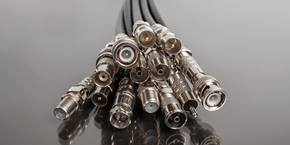By Gary Elinoff, contributing writer

Image source: Arrow Electronics.
In our world of cutting-edge digital technology that can do astonishing things hundreds of millions of times per second, we tend to give short shrift to the lowly connector. Bad mistake, because no matter how marvelous our device is, nobody will know about it without data I/O, and without a source of power, it won’t be doing anything in any case. Choosing the right one for the job is no easy task because there is a vast array of commercially available mechanical connectors available to choose from, but here are some basic criteria to guide the search.
Electrical parameters
Will the connector pass micro-amps of signal or many amperes of power? Will digital or analog signals, high frequency or low frequency, or maybe a combination have to be accommodated? Will shielding be needed to protect signal integrity? The same connector that passes electrical signals in any combination may also have to play host to fiber-optic information. In the case of medical equipment, liquid or gas may need to pass through the same portal, and a custom connector may be needed.
Constraints
Are you building a desktop or a smartphone? The same combinations of signal and power may have to be conveyed into or out of either device, but obviously, it will have to be squeezed into a lot less space in the latter, and into less space still for a wearable device.
Environmental conditions
Will the connector be subject to vibration or shock or extremes of temperature? Fortunately, most manufacturers’ data sheets will spell out the capability of their connectors to operate under these types of challenges, and your attention to detail will protect you from under- or over-specifying.
There are also specialized connectors that resist water, gas, or even oil. Your design spec for a connector may specify a required level of protection that must be provided against moisture, dirt, and other hazards. This level is often described in term of an IP code, which, again, is usually defined by the connector’s specification sheet.
Medical and food applications are environmentally challenging, as is the automotive area, and devices for the aerospace and maritime world are even more so. Class 1, Division 2 hazardous locations may have flammable or combustible gasses and liquids present, and this is yet another hazard that a connector may have to guard against.
Specific industry standards
Specific industries impose specific standards. For example, the FDA is deeply involved in medical equipment standards, the automotive industry has its SAE standards, and the military presents its voluminous array of MIL standards.
Reliability
This is an area where over-specifying is expensive, and under-specifying will lead to recalls or worse. It often depends simply on how often a cable will be mated and unmated to a connector. What makes reliability hard to get a handle on is that, in some extremely challenging applications, a connector may have to be mated and unmated to cable very few times in the life of a device, and some otherwise benign applications, such as connecting and un-connecting a cellphone’s mini-USB connector to its charging cable, may need to occur many times each week.
Connectors may seem simple or dull, but the unavoidable fact is that the vast majority of electronic devices that fail before they become obsolete do so due to mechanical causes rather than through electrical failure. The engineer that doesn’t pay sufficient attention to mechanical issues, such as well-thought-out connector selection, does so at his own peril.
Advertisement
Learn more about Electronic Products Magazine





